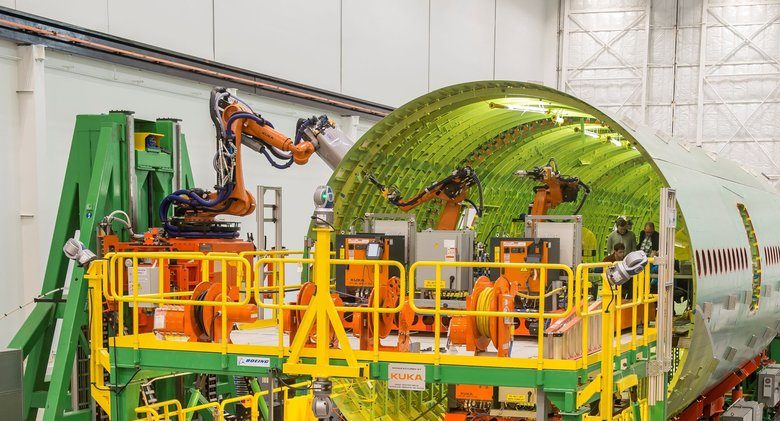
Boeing said Wednesday it is reverting to an older approach that "has proven more reliable, requiring less work by hand and less rework, than what the robots were capable of."
The robotic system entailed holding the large curved metal panels that make up the 777 fuselage sections right-side up in a cradle as the moving robots stitched the panels together, drilling holes and adding tens of thousands of fasteners.
Because this was different from the traditional build process in which the lower fuselage was built upside down, then flipped before the upper fuselage was added, Boeing awkwardly dubbed it the "Fuselage Automated Upright Build" process or FAUB.
The main system used on the forward and aft fuselage sections involved mechanics tacking the panels together then stepping back to let four robots apply permanent fasteners.
One pair of robots drilled and fastened in unison on the upper half of the fuselage section — one inside, one outside. The outside robot inserted a rivet while the inside one simultaneously flattened it at the other end to create the fastening. A second pair of robots worked the lower half in similar fashion.
The technology was implemented gradually from 2015 inside a new building on the Everett site. But right from the start, the robots proved painful to set up and error-prone, producing damaged fuselages and others that were incompletely assembled and had to be finished by hand.
"FAUB is a horrible failure," one mechanic told the Seattle Times in 2016. Another called the system "a nightmare" that was snarling 777 production. Yet Boeing insisted then that these were teething pains that would pass.
"It's a little tough in the teething," Jason Clark, Boeing vice president of 777/777X operations, said then. "But as we get through it, it will create the rewards necessary for us to compete."
The pain didn't pass, however, and Boeing said Wednesday it's scrapping the technology.
This summer it began reverting to an older, smaller-scale, flexible automation tool called a "flex track" that will only drill the holes, leaving machinists to manually add the fasteners. Boeing said it expects the transition out of the FAUB technology to be complete by the end of the year.
The flex track is a small mobile machine very different from the completely automated, autonomous manufacturing cell that is the FAUB concept. It moves on rails that are attached to the fuselage and moves around the circumference drilling the holes. Mechanics then lift it off and move it to the next station to drill the next set of holes.
News of the dramatic technology shift was first reported Wednesday by Bloomberg News.
The 777's more complex mid-fuselage section, which includes the center wing box and the stubs of the wings, was always assembled differently in the same building. Only an outside robot is used, installing two-sided fasteners — not rivets — while mechanics chase its work inside, manually installing collars on the fasteners. This mid-fuselage work will continue as is.
In addition, Boeing continues to use highly automated autonomous robotic systems on other parts of the 777 assembly process, including the fabrication of the 777X carbon composite wing parts in the $1 billion Composite Wing Center and the assembly of the giant wings in the main assembly plant.
Those robotic systems, developed by Electroimpact of Everett, are performing to specification, Boeing said.
Boeing worked closely with German automated engineering firm KUKA Systems to implement the FAUB technology. It first developed the system in secret, far from prying eyes inside a former boat-manufacturing facility in Anacortes in 2013 and then publicly announced it at the Farnborough Air Show the following year.
The automation has never delivered its promise of reduced hand labor and Boeing has had to maintain a substantial workforce of mechanics to finish the work of the robots. Because of the errors in the automation, that often took longer than if they had done it all by hand from the start. Boeing said Wednesday there are no planned changes in total staffing.
It's taken six years to finally throw in the towel. Boeing said it doesn't yet know what it will do with the forward and aft robots.
Video: A behind the scenes look at Fuselage Automated Upright Build (FAUB). (Boeing, 2017)



Comment: Well, maybe the robots won't be taking over quite as soon as predicted.